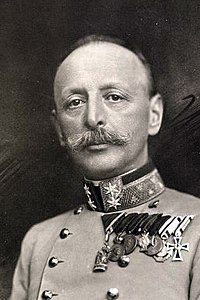Siege of Anlaufhafen
This article is incomplete because it is pending further input from participants, or it is a work-in-progress by one author. Please comment on this article's talk page to share your input, comments and questions. Note: To contribute to this article, you may need to seek help from the author(s) of this page. |
| Siege of Anlaufhafen | |||||||||
|---|---|---|---|---|---|---|---|---|---|
| Part of the Alemannic Theater of the First Great War | |||||||||
 The destroyed X district in Anlaufhafen after Hytekojuznik shelling in 1897 | |||||||||
| |||||||||
| Belligerents | |||||||||
|
| File:LiiduriaFlag.png Liiduria | ||||||||
| Strength | |||||||||
|
1896: 186,000 in 7 divisions 1898: 460,000 in 15 divisions | Unknown | ||||||||
| Casualties and losses | |||||||||
|
279,000 114,000 KIA 165,000 to disease and famine | Unknown | ||||||||
The Siege of Anlaufhafen was the longest and largest siege of the First Great War, with over 600,000 total personnel involved throughout the siege. The siege lasted from early-1896, when the Kingdom of Hytekojuznia first entered the war, to May 1898, when Anlaufhafen was taken by Hytekojuznik forces. The siege is often regarded as a pyrrhic victory for the Hytekojuznik forces, and began their eventual downfall and surrender to the Leidense-Liidurian Bipartite in 1899.
Background
Upon the outbreak of the war in 1895, Hytekojuznik opinion was divided as to whether to get involved, as the Grand Alliance did not pose a threat to the country. The beginning of costly battles like the Battle of the Azur made many higher-ups in the country sceptical as to whether involvement in the conflict was necessary. As the war grew in size, Liidurian troops were increasingly spread out further as fighting ensued in places like Chokashia, Miersa and Dosceriche; many of which were relocated from the defenses of Anlaufhafen.
Anlaufhafen was a territorial ambition of Hytekojuznia ever since it unified in 1884, and the city was tactically important for Hytekojuznia to reduce Liidurian influence in Alemannia as well as gaining greater control of trade in the Gulf of Alemannia and Strait of Edressder (Anlaufhafen allowed Liiduria to seal off the latter). The city was an important port for the Liidurians and a vital city for their participation in the Alemannic Theater, making the defense of the city of importance to Liiduria. Johannes II, King of Hytekojuznia, approved partial mobilisation on the first day of 1896, and permission for full mobilisation was approved a week later on January 8. Eleven days after full mobilisation approved, the first shells were fired on Anlaufhafen and Hytekojuznia issued a declaration of war to the Leidense-Liidurian Bipartite.
Around 45 kilometres (28 mi) of new trenches were dug in five levels of defense of the city by Liiduria, and these defenses were later aided by around 800 km of barbed wire and fences surrounding the perimeter of the city. The initial military garrison of X as well as X civilians were surrounded by seven Hytekojuznik divisions totalling some 186,000 troops in size. The siege of Anlaufhafen displayed what many had thought to be a problem within the Hytekojuznik armies, orders had to be issued in several languages and racial tensions constantly threatened the organisation, discipline and morale of the besieging armies.
First siege
The first shells were fired on the city on January 19 at just after dawn. Juznik general Teofilis Vilmanas lacked an appropriate number of siege artillery to effectively begin an assault of Anlaufhafen, but he intended to quickly advance on the city and make a large push in an attempt to breach to half-prepared Liidurian defenses before a relief force could be sent. Vilmanas issued several orders to push for the city during the first days of the siege, the first of which came on January 21, where one-and-a-half divisions of around 30,000 men were ordered to attempt to push past the defenses. The push was poorly commanded and led and the disorganised advance was repelled by the Liidurians and forced into a retreat, sustaining around 12,000 casualties by the time the army had retreated to the Hytekojuznik lines. The second and third orders of advanced sustained similar fates, and by the end of January the Hytekojuznik forces had already suffered over 30,000 losses without making any gains.
Artillery pieces arrived from the Hytekojuznik High Command on February 2, although they were still not in sufficient numbers, so Vilmanas retreated and regrouped after the advances and instead ordered for continuous bombardment of the defenses with the new guns. The Liidurian trenches provided basic defenses against the shellings but the defenders still sustained some significant casualties during the bombardment. Vilmanas soon found that ammunition shortages were becoming a regular occurrence as more and more resources were dedicated to fighting in northern Juznia against the Second Leidense Regency. The lack of ammunition coupled with the increasing number of starvation-related casualties of the Hytekojuznik forces caused Vilmanas to lift the siege on April 12, and retreated to the nearby camp in the town of Karšpel to regroup and recuperate the armies. After the lifting of siege, many civilians were evacuated from Anlaufhafen for the safety and also to combat food shortages for the soldiers defending the city.
Hytekojuznik tallies vary, but it is agreed that around 55,000-60,000 soldiers died during the first siege phase whilst the army was under the command of Vilmanas, who was relocated to the Hyteko-Leidense Front in late April. The Leidense Regency increased fighting efforts in an attempt to move soldiers away from Anlaufhafen to reduce the size of assaulting armies, but by May the size of the besieging armies had reached ten divisions with around 275,000 troops. A Liidurian relief force arrived in the city during May, and Liidurian general X hoped that the relief force plus the soldiers already stationed in Anlaufhafen would be able to deal a significant blow to the advancing Hytekojuznik armies, although they were unaware of the army's increase in size.

